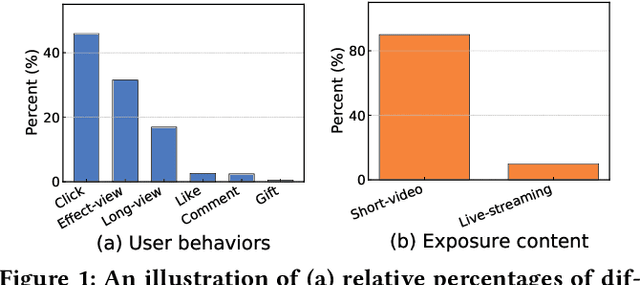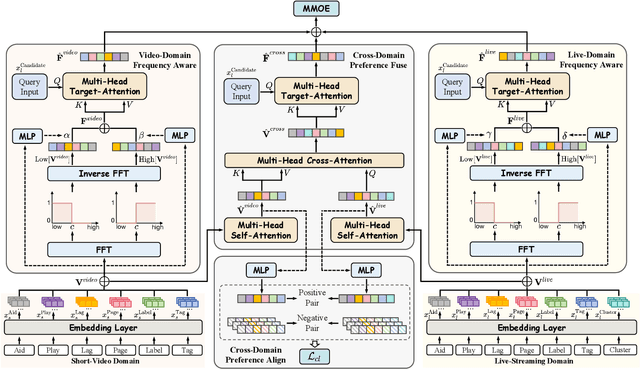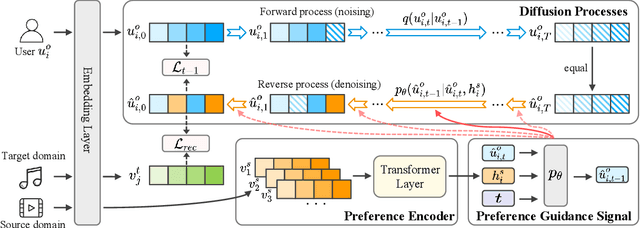Xiaodong Li
Enhanced Influence-aware Group Recommendation for Online Media Propagation
Jul 02, 2025Abstract:Group recommendation over social media streams has attracted significant attention due to its wide applications in domains such as e-commerce, entertainment, and online news broadcasting. By leveraging social connections and group behaviours, group recommendation (GR) aims to provide more accurate and engaging content to a set of users rather than individuals. Recently, influence-aware GR has emerged as a promising direction, as it considers the impact of social influence on group decision-making. In earlier work, we proposed Influence-aware Group Recommendation (IGR) to solve this task. However, this task remains challenging due to three key factors: the large and ever-growing scale of social graphs, the inherently dynamic nature of influence propagation within user groups, and the high computational overhead of real-time group-item matching. To tackle these issues, we propose an Enhanced Influence-aware Group Recommendation (EIGR) framework. First, we introduce a Graph Extraction-based Sampling (GES) strategy to minimise redundancy across multiple temporal social graphs and effectively capture the evolving dynamics of both groups and items. Second, we design a novel DYnamic Independent Cascade (DYIC) model to predict how influence propagates over time across social items and user groups. Finally, we develop a two-level hash-based User Group Index (UG-Index) to efficiently organise user groups and enable real-time recommendation generation. Extensive experiments on real-world datasets demonstrate that our proposed framework, EIGR, consistently outperforms state-of-the-art baselines in both effectiveness and efficiency.
Micro-Act: Mitigate Knowledge Conflict in Question Answering via Actionable Self-Reasoning
Jun 05, 2025Abstract:Retrieval-Augmented Generation (RAG) systems commonly suffer from Knowledge Conflicts, where retrieved external knowledge contradicts the inherent, parametric knowledge of large language models (LLMs). It adversely affects performance on downstream tasks such as question answering (QA). Existing approaches often attempt to mitigate conflicts by directly comparing two knowledge sources in a side-by-side manner, but this can overwhelm LLMs with extraneous or lengthy contexts, ultimately hindering their ability to identify and mitigate inconsistencies. To address this issue, we propose Micro-Act a framework with a hierarchical action space that automatically perceives context complexity and adaptively decomposes each knowledge source into a sequence of fine-grained comparisons. These comparisons are represented as actionable steps, enabling reasoning beyond the superficial context. Through extensive experiments on five benchmark datasets, Micro-Act consistently achieves significant increase in QA accuracy over state-of-the-art baselines across all 5 datasets and 3 conflict types, especially in temporal and semantic types where all baselines fail significantly. More importantly, Micro-Act exhibits robust performance on non-conflict questions simultaneously, highlighting its practical value in real-world RAG applications.
Hyperbolic-PDE GNN: Spectral Graph Neural Networks in the Perspective of A System of Hyperbolic Partial Differential Equations
May 29, 2025Abstract:Graph neural networks (GNNs) leverage message passing mechanisms to learn the topological features of graph data. Traditional GNNs learns node features in a spatial domain unrelated to the topology, which can hardly ensure topological features. In this paper, we formulates message passing as a system of hyperbolic partial differential equations (hyperbolic PDEs), constituting a dynamical system that explicitly maps node representations into a particular solution space. This solution space is spanned by a set of eigenvectors describing the topological structure of graphs. Within this system, for any moment in time, a node features can be decomposed into a superposition of the basis of eigenvectors. This not only enhances the interpretability of message passing but also enables the explicit extraction of fundamental characteristics about the topological structure. Furthermore, by solving this system of hyperbolic partial differential equations, we establish a connection with spectral graph neural networks (spectral GNNs), serving as a message passing enhancement paradigm for spectral GNNs.We further introduce polynomials to approximate arbitrary filter functions. Extensive experiments demonstrate that the paradigm of hyperbolic PDEs not only exhibits strong flexibility but also significantly enhances the performance of various spectral GNNs across diverse graph tasks.
* 18 pages, 2 figures, published to ICML 2025
Mitigating Modality Bias in Multi-modal Entity Alignment from a Causal Perspective
Apr 29, 2025



Abstract:Multi-Modal Entity Alignment (MMEA) aims to retrieve equivalent entities from different Multi-Modal Knowledge Graphs (MMKGs), a critical information retrieval task. Existing studies have explored various fusion paradigms and consistency constraints to improve the alignment of equivalent entities, while overlooking that the visual modality may not always contribute positively. Empirically, entities with low-similarity images usually generate unsatisfactory performance, highlighting the limitation of overly relying on visual features. We believe the model can be biased toward the visual modality, leading to a shortcut image-matching task. To address this, we propose a counterfactual debiasing framework for MMEA, termed CDMEA, which investigates visual modality bias from a causal perspective. Our approach aims to leverage both visual and graph modalities to enhance MMEA while suppressing the direct causal effect of the visual modality on model predictions. By estimating the Total Effect (TE) of both modalities and excluding the Natural Direct Effect (NDE) of the visual modality, we ensure that the model predicts based on the Total Indirect Effect (TIE), effectively utilizing both modalities and reducing visual modality bias. Extensive experiments on 9 benchmark datasets show that CDMEA outperforms 14 state-of-the-art methods, especially in low-similarity, high-noise, and low-resource data scenarios.
SOTOPIA-Ω: Dynamic Strategy Injection Learning and Social Instrucion Following Evaluation for Social Agents
Feb 21, 2025Abstract:Despite the abundance of prior social strategies possessed by humans, there remains a paucity of research dedicated to their transfer and integration into social agents. Our proposed SOTOPIA-{\Omega} framework aims to address and bridge this gap, with a particular focus on enhancing the social capabilities of language agents. This framework dynamically injects multi-step reasoning strategies inspired by negotiation theory, along with two simple direct strategies, into expert agents, thereby automating the construction of high-quality social dialogue training corpus. Additionally, we introduce the concept of Social Instruction Following (S-IF) and propose two new S-IF evaluation metrics that are complementary to social capability. We demonstrate that several 7B models trained on high-quality corpus not only significantly surpass the expert agent (GPT-4) in achieving social goals but also enhance S-IF performance. Analysis and variant experiments validate the advantages of dynamic construction, which can especially break the agent's prolonged deadlock.
Factor Graph-based Interpretable Neural Networks
Feb 20, 2025Abstract:Comprehensible neural network explanations are foundations for a better understanding of decisions, especially when the input data are infused with malicious perturbations. Existing solutions generally mitigate the impact of perturbations through adversarial training, yet they fail to generate comprehensible explanations under unknown perturbations. To address this challenge, we propose AGAIN, a fActor GrAph-based Interpretable neural Network, which is capable of generating comprehensible explanations under unknown perturbations. Instead of retraining like previous solutions, the proposed AGAIN directly integrates logical rules by which logical errors in explanations are identified and rectified during inference. Specifically, we construct the factor graph to express logical rules between explanations and categories. By treating logical rules as exogenous knowledge, AGAIN can identify incomprehensible explanations that violate real-world logic. Furthermore, we propose an interactive intervention switch strategy rectifying explanations based on the logical guidance from the factor graph without learning perturbations, which overcomes the inherent limitation of adversarial training-based methods in defending only against known perturbations. Additionally, we theoretically demonstrate the effectiveness of employing factor graph by proving that the comprehensibility of explanations is strongly correlated with factor graph. Extensive experiments are conducted on three datasets and experimental results illustrate the superior performance of AGAIN compared to state-of-the-art baselines.
NaturalL2S: End-to-End High-quality Multispeaker Lip-to-Speech Synthesis with Differential Digital Signal Processing
Feb 17, 2025



Abstract:Recent advancements in visual speech recognition (VSR) have promoted progress in lip-to-speech synthesis, where pre-trained VSR models enhance the intelligibility of synthesized speech by providing valuable semantic information. The success achieved by cascade frameworks, which combine pseudo-VSR with pseudo-text-to-speech (TTS) or implicitly utilize the transcribed text, highlights the benefits of leveraging VSR models. However, these methods typically rely on mel-spectrograms as an intermediate representation, which may introduce a key bottleneck: the domain gap between synthetic mel-spectrograms, generated from inherently error-prone lip-to-speech mappings, and real mel-spectrograms used to train vocoders. This mismatch inevitably degrades synthesis quality. To bridge this gap, we propose Natural Lip-to-Speech (NaturalL2S), an end-to-end framework integrating acoustic inductive biases with differentiable speech generation components. Specifically, we introduce a fundamental frequency (F0) predictor to capture prosodic variations in synthesized speech. The predicted F0 then drives a Differentiable Digital Signal Processing (DDSP) synthesizer to generate a coarse signal which serves as prior information for subsequent speech synthesis. Additionally, instead of relying on a reference speaker embedding as an auxiliary input, our approach achieves satisfactory performance on speaker similarity without explicitly modelling speaker characteristics. Both objective and subjective evaluation results demonstrate that NaturalL2S can effectively enhance the quality of the synthesized speech when compared to state-of-the-art methods. Our demonstration page is accessible at https://yifan-liang.github.io/NaturalL2S/.
FARM: Frequency-Aware Model for Cross-Domain Live-Streaming Recommendation
Feb 13, 2025



Abstract:Live-streaming services have attracted widespread popularity due to their real-time interactivity and entertainment value. Users can engage with live-streaming authors by participating in live chats, posting likes, or sending virtual gifts to convey their preferences and support. However, the live-streaming services faces serious data-sparsity problem, which can be attributed to the following two points: (1) User's valuable behaviors are usually sparse, e.g., like, comment and gift, which are easily overlooked by the model, making it difficult to describe user's personalized preference. (2) The main exposure content on our platform is short-video, which is 9 times higher than the exposed live-streaming, leading to the inability of live-streaming content to fully model user preference. To this end, we propose a Frequency-Aware Model for Cross-Domain Live-Streaming Recommendation, termed as FARM. Specifically, we first present the intra-domain frequency aware module to enable our model to perceive user's sparse yet valuable behaviors, i.e., high-frequency information, supported by the Discrete Fourier Transform (DFT). To transfer user preference across the short-video and live-streaming domains, we propose a novel preference align before fuse strategy, which consists of two parts: the cross-domain preference align module to align user preference in both domains with contrastive learning, and the cross-domain preference fuse module to further fuse user preference in both domains using a serious of tailor-designed attention mechanisms. Extensive offline experiments and online A/B testing on Kuaishou live-streaming services demonstrate the effectiveness and superiority of FARM. Our FARM has been deployed in online live-streaming services and currently serves hundreds of millions of users on Kuaishou.
Foundation Models for Anomaly Detection: Vision and Challenges
Feb 10, 2025



Abstract:As data continues to grow in volume and complexity across domains such as finance, manufacturing, and healthcare, effective anomaly detection is essential for identifying irregular patterns that may signal critical issues. Recently, foundation models (FMs) have emerged as a powerful tool for advancing anomaly detection. They have demonstrated unprecedented capabilities in enhancing anomaly identification, generating detailed data descriptions, and providing visual explanations. This survey presents the first comprehensive review of recent advancements in FM-based anomaly detection. We propose a novel taxonomy that classifies FMs into three categories based on their roles in anomaly detection tasks, i.e., as encoders, detectors, or interpreters. We provide a systematic analysis of state-of-the-art methods and discuss key challenges in leveraging FMs for improved anomaly detection. We also outline future research directions in this rapidly evolving field.
Exploring Preference-Guided Diffusion Model for Cross-Domain Recommendation
Jan 20, 2025



Abstract:Cross-domain recommendation (CDR) has been proven as a promising way to alleviate the cold-start issue, in which the most critical problem is how to draw an informative user representation in the target domain via the transfer of user preference existing in the source domain. Prior efforts mostly follow the embedding-and-mapping paradigm, which first integrate the preference into user representation in the source domain, and then perform a mapping function on this representation to the target domain. However, they focus on mapping features across domains, neglecting to explicitly model the preference integration process, which may lead to learning coarse user representation. Diffusion models (DMs), which contribute to more accurate user/item representations due to their explicit information injection capability, have achieved promising performance in recommendation systems. Nevertheless, these DMs-based methods cannot directly account for valuable user preference in other domains, leading to challenges in adapting to the transfer of preference for cold-start users. Consequently, the feasibility of DMs for CDR remains underexplored. To this end, we explore to utilize the explicit information injection capability of DMs for user preference integration and propose a Preference-Guided Diffusion Model for CDR to cold-start users, termed as DMCDR. Specifically, we leverage a preference encoder to establish the preference guidance signal with the user's interaction history in the source domain. Then, we explicitly inject the preference guidance signal into the user representation step by step to guide the reverse process, and ultimately generate the personalized user representation in the target domain, thus achieving the transfer of user preference across domains. Furthermore, we comprehensively explore the impact of six DMs-based variants on CDR.
 Add to Chrome
Add to Chrome Add to Firefox
Add to Firefox Add to Edge
Add to Edge